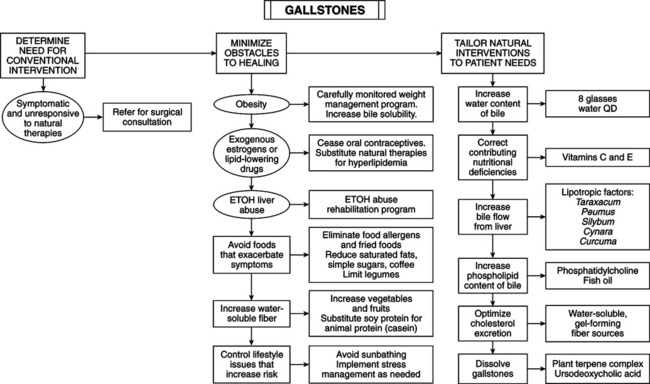• Four categories: (1) pure cholesterol; (2) pure pigment (calcium bilirubinate); (3) mixed, containing cholesterol and derivatives plus bile salts, pigments, and inorganic calcium salts; (4) mineral. • Pure stones (cholesterol or calcium bilirubinate) are rare in the United States, where 80% are mixed and 20% are exclusively minerals (calcium salts, oxides of silicon and aluminum). • Gender: frequency is two to four times greater in women than in men. Women are predisposed because of either increased cholesterol synthesis or suppression of bile acids by estrogens. Pregnancy, oral contraceptives, or other causes of elevated estrogen increase incidence. • Genetic and ethnic: gallstones are most common in Native American women older than 30 years (70% have gallstones). Only 10% of black women older than 30 years have gallstones. Differences reflect extent of cholesterol saturation of bile. Dietary factors outweigh genetic factors. • Obesity: increases activity of 3-hydroxy-3-methylglutaryl coenzyme A (HMG CoA) reductase and secretion of cholesterol in bile from increased cholesterol synthesis. Obesity is linked to much increased incidence because of biliary cholesterol saturation. During active weight reduction, biliary cholesterol saturation initially increases. Secretion of biliary lipids is reduced during weight loss, but secretion of bile acids decreases more than cholesterol. When weight is stabilized, bile acid output returns to normal and cholesterol output remains low. Net effect is a significant reduction in cholesterol saturation. Prolonged dietary fat reduction can promote biliary stasis, causing cholesterol saturation. 10+ g of fat daily are needed for proper GB emptying. • Gastrointestinal tract diseases: Crohn’s disease and cystic fibrosis involve malabsorption of bile acids from the terminal ileum that disturbs enterohepatic circulation by reducing bile acid pool and rate of bile secretion. • Drugs: tamoxifen increases gallstones. Over 5 years, incidence of stones in tamoxifen-treated patients was 37.4% versus 2.0% in those not taking drug. Other problematic agents are oral contraceptives, other estrogens, cephalosporin ceftriaxone, octreotide, HMG CoA reductase inhibitors, and possibly other lipid-lowering drugs. • Age: average gallstone patient is 40-50 years old. Incidence increases with age because of inactivity of cholesterol 7-alpha-hydroxylase with increased biliary cholesterol hypersecretion, cholesterol saturation, and accelerated stone formation. • Risk factors for pigmented gallstones: geography, sun exposure, severe diseases. They are more common in Asia because of liver and GB parasites (liver fluke Clonorchis sinensis). Bacteria and protozoa cause stasis or act as nucleating agents. In the United States, pigmented stones are caused by chronic hemolysis or alcohol liver cirrhosis. • Dietary fiber: diet high in refined carbohydrates and fat and low in fiber reduces liver synthesis of bile acids and lowers bile acids in the GB. Fiber reduces absorption of deoxycholic acid, produced from bile acids by gut bacteria, which lessens solubility of cholesterol in bile. Fiber decreases formation of deoxycholic acid and binds deoxycholic acid for fecal excretion. Prefer water-soluble fibers: vegetables, fruits, pectin, oat bran, and guar gum. Diets rich in legumes with water-soluble fiber (Native Americans) are linked to increased risk for cholesterol gallstones. Legumes increase biliary cholesterol saturation because of saponin content; restrict legume intake with gallstones. • Vegetarian diet: protective against gallstones because of fiber content. Animal proteins (casein from dairy) increase formation of gallstones; vegetable proteins (soy) are preventive against gallstones. • Food allergies: food allergies may cause GB pain. One study demonstrated 100% of patients to be symptom free while on elimination diet (beef, rye, soybeans, rice, cherries, peaches, apricots, beets, spinach). Foods inducing symptoms, in decreasing order of occurrence, are: egg, pork, onion, fowl, milk, coffee, citrus, corn, beans, nuts. Ingestion of allergy-causing substances may cause swelling of bile ducts, impairing bile flow from GB. • Buckwheat: decreases gallstone formation and reduces concentration of cholesterol in GB, plasma, and liver of animals compared with casein. Buckwheat is far more protective than soy. Buckwheat can enhance bile acid synthesis and fecal excretion of steroids. It may treat both hypercholesterolemia and gallstones and reduce colon cancer cell proliferation. Higher levels of arginine and glycine may help in buckwheat’s protective function. • Sugars: increase risk of biliary tract cancer based on relation between sugars, blood lipids, and gallstone formation. Sugar increases cholesterol saturation of bile. Gallstones are linked to monosaccharides and disaccharides, independent of other energy sources. • Caloric restriction: total calorie and carbohydrate intake and serum triglycerides are higher in gallstone patients than in control subjects. Refined carbohydrate intake is higher in female gallstone patients; fat intake is higher in male gallstone patients. Caloric intake of more than 2500 kcal/day and diets rich in carbohydrates and saturated fats increased gallstone risk. Alcohol intake at 20-40 g/day was protective. Caloric restriction must be instituted carefully because rapid weight loss and fasting increase risk of gallstones. Those who develop gallstones have higher baseline triglyceride and total cholesterol and greater rate of weight loss than those who did not. • Coffee: can promote symptoms of gallstones but may also inhibit their formation. Avoid coffee until stones are resolved: coffee (regular and decaffeinated) induces GB contractions by cholecystokinin secretion. In women, 4 cups of caffeinated coffee daily induce 28% lower risk of developing symptoms of gallstones. Drinking coffee regularly before or during early stone formation may inhibit development or clear small stones by enhanced GB contractions from multiple daily coffee doses. Large existing stones may exacerbate symptoms if contractions are induced by coffee.
Gallstones
GENERAL CONSIDERATIONS
PATHOGENESIS

THERAPEUTIC CONSIDERATIONS
Diet
![]()
Stay updated, free articles. Join our Telegram channel

Full access? Get Clinical Tree


Gallstones
